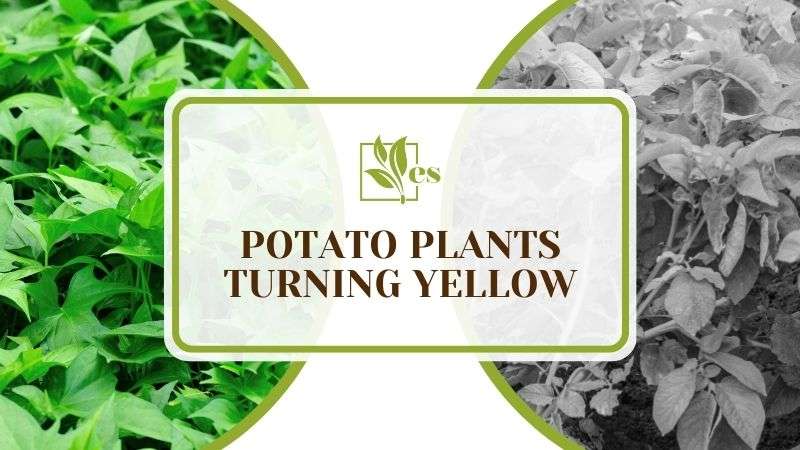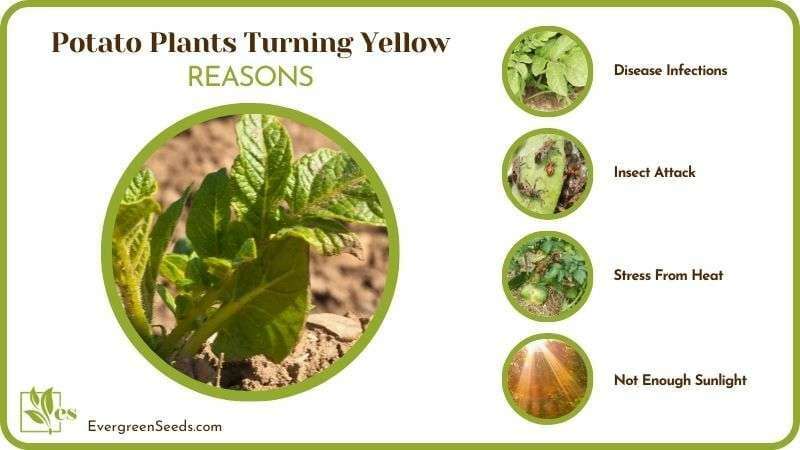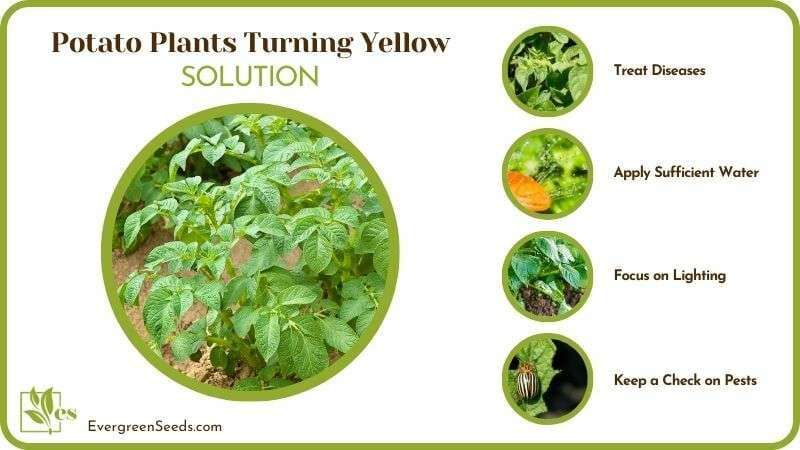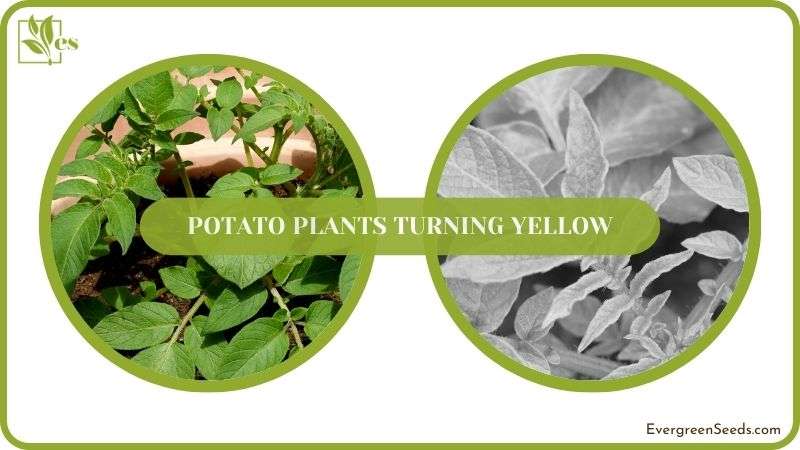Potato plants turning yellow is a serious problem caused by disease infections, insect infestation, temperature stress, mineral deficiencies, and nutrient toxicity.

But the good thing is that you can easily fix such plants – by treating diseases and applying sufficient water among others.
Continue reading about the causes of yellowing and how to deal with them easily. Also, did you know that you can water your plants with potato water?
JUMP TO TOPIC
What Are the Reasons Behind a Potato Plant Turning Yellow?
The reasons behind this plant becoming yellow are disease infections, insect attacks, improper watering, incorrect lighting, and nutrient unavailability. Moreover, if there is any temperature stress, it can also cause the leaves to change their color to yellow.
– Disease Infections
One of the main reasons why plants turn yellow is diseases. Verticillium wilt is a common fungal disease that causes the yellowing of leaves and browning of the stem near the soil. Fusarium wilt is another disease that directly damages the xylem (water-taking vessels). In this, the lower leaves become yellow first, and the whole plant can wilt and die after some time.
Furthermore, early blight is another disease caused by Alternaria solani fungus. It causes circular to angular yellowish-brown spots on the leaves and causes them to drop. Moreover, late blight is another fungal disease that causes small yellow to brown blotches on lower leaves. So, when you see potato plant leaves turning brown and yellow, then chances are fungal diseases are attacking them.
The common bacterial disease of potatoes is bacterial ring rot. Plants infected by them have water-soaked spots on their tubers. The damage can then spread to the stem and leaves. After a while, you will eventually see potato plants turning yellow with black spots.
– Insect Attack
In addition to diseases, potato leaves turn yellow when severe insect infestation occurs. The common ones that love to feast on leaves are leaf miners, aphids, beetles, and leafhoppers. They love to suck the sap, that has to effect of the leaves turning yellow.
Moreover, white flies also love to attack the leaves of potatoes. When they suck cell sap, they leave sooty mold on leaves, which can cause a decline in photosynthesis. As a result, yellowing will start to occur.
– Stress From Heat
Plants might face heat stress when they see yellow leaves, and it’s a hot day. This plant can tolerate temperatures up to 100 degrees Fahrenheit. When it is more than that, the leaves will start to dry up. When all the moisture evaporates, the leaves curl up and become yellow.
In addition, when there is heat stress, sunburn is also higher. In this condition, the UV rays of light kill the leaf cells, which causes yellow spots to emerge. When the condition persists, you will also see potato leaves wilting.
Sometimes, the temperature is fine, and plants still face heat stress. It happens when you place them near a radiator or vent. So, make sure plants don’t put plants in places with a vent or a radiator nearby.

– Not Enough Sunlight
When you notice pale potato leaves, plants are not getting optimal light. Potatoes need around six hours of light to thrive. But when you grow them in such spots where there is shade or light falls for only a few minutes, the leaves will start to discolor.
The reason for discoloration is that plants need light for physiological functions like photosynthesis. So, when it is insufficient, these processes won’t take place, and there will eventually be energy or food shortages in plants. First, you will see them getting pale, and then the yellowing will become more prominent with time.
– Adding Too Much Water
When you see potato leaves turning brown to yellow, and the soil is overly moist, it means the main culprit is overwatering. Let us explain. When you add lots of water, the roots stay submerged in moisture, which is undesirable. It is because submerged roots have very limited access to oxygen. So, they suffocate and won’t be able to function (absorbing moisture and minerals). This will impact the physiological functions happening in leaves, which will eventually start turning them yellow.
Similarly, excessively moist soil can also invite diseases. We all know that fungus loves humid environments and damp soil. So, when you add too much water, the chances of fungal attacks go way up, which can cause yellowing.
– Cold Temperature
Cold or low temperatures can also cause plants to turn yellow. The minimum temperature potatoes can tolerate 29 degrees Fahrenheit. When it drops below, problems will occur. Low temperatures can remain dormant in the plant’s growth because physiological processes stop. When this happens, the leaves will start having yellow patches.
Furthermore, if there is frost, then it causes the moisture in the leaves to freeze up. This will also cause them to become yellow. If frosting persists, you will also have to deal with potato plants dying before flowering.
– Mineral Deficiency
Another reason that leads to potato plants turning yellow before flowering is mineral or nutrient deficiencies. Minerals are important for plants because they are growth boosters.
So, when plants lack them, you will see leaves turning brown to yellow. The deficiency that hits plants the hardest is nitrogen deficiency. Nitrogen is a macronutrient that plants need to grow greener and taller. It is a part of chlorophyll, a pigment that gives green color to leaves. So, when it is low, chlorophyll cannot produce the green color, and leaves will be discolored or yellowing.
Similarly, magnesium deficiency is also bad for plants. Magnesium also aids in chlorophyll production, so its deficiency causes yellowing. Other nutrients crucial to maintaining a plant’s shape and color are potassium, phosphorus, iron, zinc, boron, and sulphur.
– Nutrient Toxicity
Just like deficiency, adding lots of nutrients is not a good thing. It is because over-fertilization causes growing problems, as a phenomenon called nutrient toxicity occurs due to this. In this, excessive nutrients change the pH of the soil, which will lock all the minerals.
When this happens, no matter how many doses you re-apply, roots will only be able to absorb nutrients if you do something about the imbalance of pH. Fortunately, it is easy to fix nutrient toxicity and all the other causes of yellowing.
How Do You Fix a Yellow Potato Plant?
You can fix the yellow leaves of potatoes by applying water and fertilizers adequately. In case of any disease or insect attack, immediately apply appropriate fungicide, bactericide, and insecticide treatments. In addition, making sure plants receive optimal light can also stop yellowing.
– Treat Diseases
When plants are under attack by bacterial and fungal diseases, you should immediately start treatments before it is too late. First, apply the appropriate fungicides and bactericides to control the spread of the disease, but don’t think applying these will be enough.
You should also keep your vegetable garden clean and tidy. The reason is that bacteria and fungi grow on dirt or debris. Similarly, when growing potatoes and seeing weeds nearby, uproot them as soon as possible. It is because they also harbor insects and diseases.
It would be best if you didn’t let water stay around potato vines, as overwatering can also lead to fungal attacks. Furthermore, cutting off infected parts is also a good move to stop the spread. Doing these things will control the diseases and won’t let them re-emerge.
– Apply Sufficient Water
It is critical to apply adequate water that should be enough to fulfill the needs of the plant. The best way is to check the soil’s moisture condition. When it is moist, it means there is already water available for roots, and they don’t need it right now. When the soil gets dry, only then apply water. Make sure to apply in controlled quantities to avoid problems like the yellowing of leaves and fungal diseases.
– Focus on Lighting
To avoid leaf yellowing, you should ensure plants get proper light for at least six hours. So, grow them in such spots where receiving this much light is possible. If you are growing them indoors, you must turn on grow lights for this period.

– Deal With Temperature Stresses Smartly
When you grow outside and the temperature is high, the light intensity is strong too. In this situation, provide shade to the plants and keep misting them to avoid heat stress. However, don’t over-mist, or a fungal attack can happen.
If you are growing them in the cold season and fear that frost can damage them, you can add mulch to maintain soil temperature. However, the best way to deal with cold stress is to sow the seeds late so plants only face frost for a short time.
– Keep a Check on Pests
To stop leaves from getting yellow, you should keep the insect population under check. Beneficial insects are good in gardens as they do pollination. But the bad ones suck the sap and turn them yellow. So, when you see insects, apply organic repellents first. These are neem oil spray, baking soda, wood ash, vinegar, etc.
But if the insect population is more, then go for chemical insecticides instead of organic ones. Ensure you wear gloves, goggles, and masks during insecticide application. Also, only go to such a spot where you applied the spray at least six hours later, as the fumes in the air can damage your health.
– Apply Fertilizers Smartly
Apply fertilizers adequately if you want your plants to avoid nutrient deficiency and toxicity. You should prefer organic fertilizers like compost, bone meal, etc., as they rarely cause toxicity and fulfill plants’ needs.
But if the yellowing is spreading fast, apply chemical fertilizers as they provide nutrients quickly. Make sure to follow dosage instructions to avoid toxicity (which can worsen the yellowing of leaves).
– Use Resistant Varieties
Among the best ways to deal with stress, one is to use resistant varieties. It is because such plants can withstand a lot of problems like insect attacks, temperature extremes, disease infections, etc.
So, please choose the right seed/variety early and purchase it from any gardening or online store. Plants grown from such seeds will have the power to tolerate complications, and you might now have to do anything to prevent them from changing their color to yellow.













